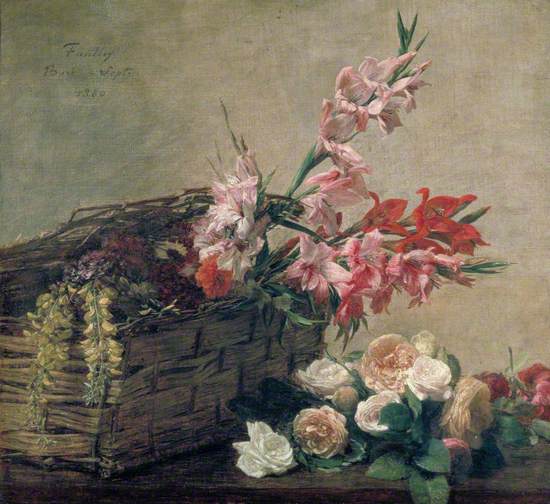Thanks to Tasha and the volunteers at Guildhall Art Gallery for their contributions.
Geoffrey Fletcher’s ‘Flowers’ (1989) oil painting depicts a loose interpretation of the Gerbera Daisy, bright and cheerful flowers that come in a variety of colours. The soil needs to be well-drained and they need lots of sunlight to grow to full bloom. Depending on variety, they can be planted in garden borders or in pots.
Geoffrey Scowcroft Fletcher (1923–2004)
Oil on canvas
H 76 x W 55 cm
City of London Corporation
‘Sun and moon flowers’ shows two women sitting by a window, one of whom cuts and arranges sunflowers. Sunflowers can contain as many as 1,000-2,000 seeds and the tallest sunflower on record was over 30 feet tall! To grow sunflowers you need a sunny, sheltered spot and a good soil – add plenty of well-rotted manure or garden compost before planting.
George Dunlop Leslie (1835–1921)
Oil on canvas
H 72 x W 72 cm
City of London Corporation
There are about 300 species of gladiolus and are recognisable by its tall flower spikes which can reach up to 90cm with numerous funnel-shaped flowers all clustered on one side of the stem. They are associated with strength and integrity and also infatuation – by giving a gladiolus to someone the giver sends the message ‘you pierce my heart’ because of the flower’s pointed shape!
Henri Fantin-Latour (1836–1904)
Oil on canvas
H 61 x W 66 cm
City of London Corporation
You can eat blackberries raw or in desserts like jellies, jams, pies, crumbles, and can even be made into wine! They are very high in antioxidants which could protect against inflammation, neurological diseases and aging. They are normally best at the end of August to September. Legend has it any picked after September are cursed by the devil!
John Pearce (b.1942)
Oil on oil-tempered hardboard
H 90 x W 123 cm
City of London Corporation
This seventeen-century man has grown his carnations in a medium-sized clay pot, each long stem supported by thin stakes; behind him a woman holds a single carnation which is being used as an allegorical representation of the sense of smell. Still popular with gardeners today, they can be grown in window boxes, raised beds or rockeries, but will need watering regularly in warmer weather.
David Teniers II (1610–1690)
Oil on copper
H 22 x W 17 cm
City of London Corporation
Harcourt depicts three young women in a beautiful garden, probably the artist’s own in Hertfordshire, surrounded by Amaryllis plants. Amaryllis reblooms every year and in the Victorian period was associated with strength and determination because of their height and sturdiness. Amaryllis is a Greek mythological name that means ‘to sparkle’. Goats aren’t the best lawnmowers for most modern gardens, but they have historically been used to keep gardens under control.
George Harcourt (1868–1947)
Oil on canvas
H 222 x W 215 cm
City of London Corporation











